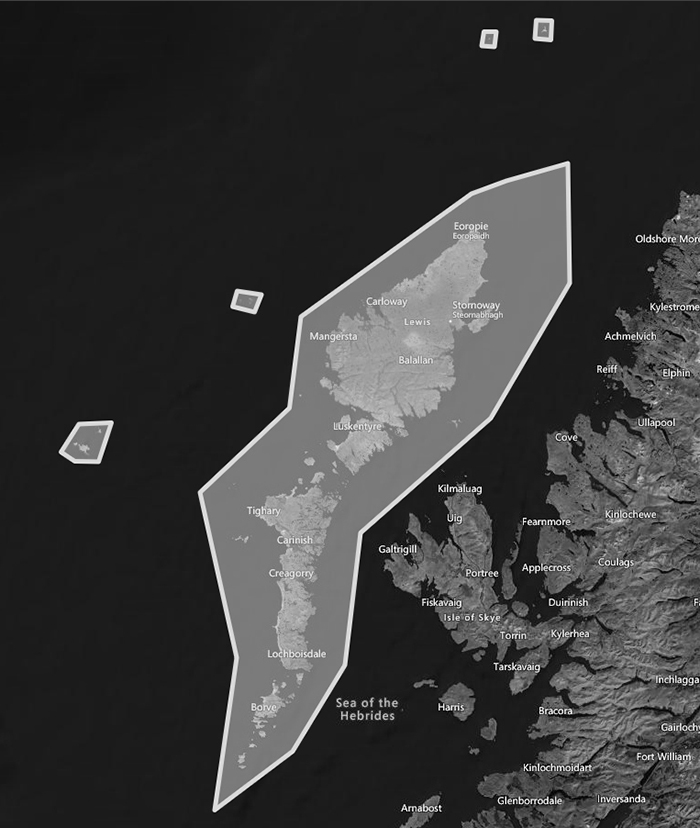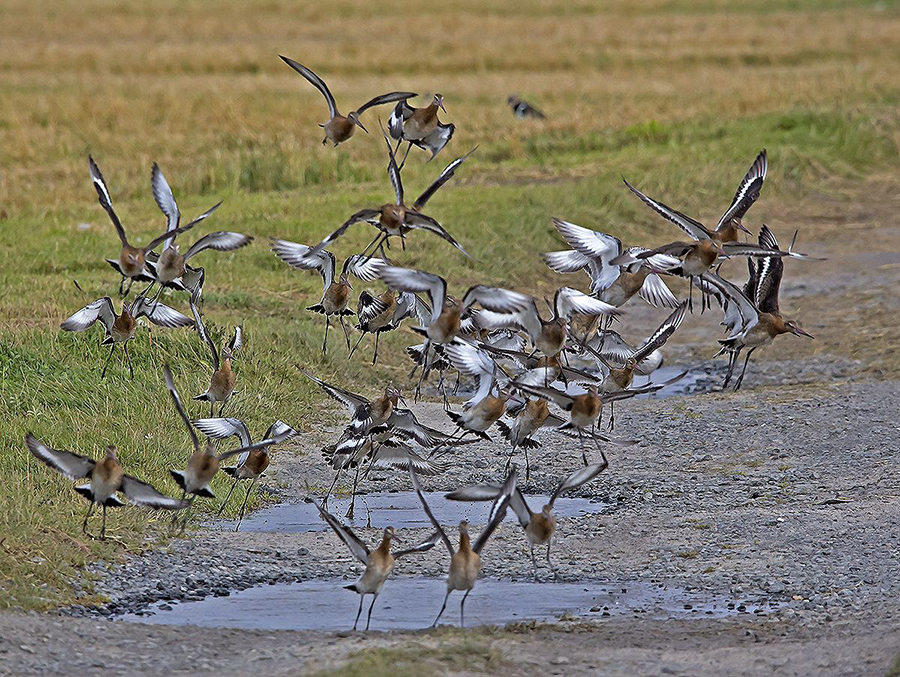The taxonomy and nomenclature follow the British List as updated in January 2021. There have been major transitions in the application of evolving species concepts and DNA-based phylogenies and the species order seems to be ever changing.
The British (English) vernacular names of each species have been adopted for this guide followed by the Gaelic name as used in The Birds of Scotland.
The Outer Hebrides recording area
The Outer Hebrides recording area consists of the Long Island and Outliers, which include the islands of North Rona, Sula Sgeir, Flannan Isles, Causamul, Shiant Islands, St Kilda (Hirta / Dun / Soay), Gasker, Haskeir Island, Monach Islands, and from Pabbay to Mingulay and Berneray / Barra Head. Offshore, the recording area extends to up to three nautical miles. Observations from ferries and boats in the Minches come under the appropriate island heading, the recording area extends to the mid-point between the island in question and the Highland or Argyll areas on the mainland side.

The Outer Hebrides recording area
Species accounts
The species accounts have been derived from records in the county archive, past bird reports, both local and national, rarities committee reports and BirdTrack. With very few exceptions, only records that have been accepted by BBRC, SBRC and OHRC have been included. If not the case, then this has been clearly stated and added for interest only.
This systematic list includes all the birds that have occurred in the Outer Hebrides. Their status and distribution have been derived from records after 1990, the year when the first Outer Hebrides Bird Report was published. This may however have been stretched a little for species when records of historical interest occurred prior to that date.
For the scarce and rare birds, most of the historical records and reports have been included where known and most dates quoted are after 1958, the year the BBRC published its first annual report. Records prior to that date have been included if there was a sufficient level of confidence in their authenticity.
When a year has been added in brackets, it indicates that a species has occurred in that year and not the number of records or individuals involved, i.e., a bird may be rare on Lewis (more than 5 but less than 25 records) but only occurred in four years as indicated by: Lewis with seven records (1996, 2001, 2011, 2018). For species that have occurred in consecutive years e.g., 2001, 2002, 2003 some have been shortened to 2001-03, and where a bird/s have remained from one year to the next, e.g., overwintered, it has been noted, by 2010/11.
Definitions used in the systematic list
| The Outer Hebrides | The entire Outer Hebrides recording area |
| The Long Island | The main chain of islands from the Butt of Lewis to Vatersay |
| The Uists | North and South Uist as described below plus Benbecula |
| North Uist | North Uist including Berneray and Grimsay |
| South Uist | South Uist including Eriskay |
| The Outliers | The islands of North Rona, Sula Sgeir, Flannan Isles, Causamul, Shiant Islands, St Kilda (Hirta/Dun/Soay), Gasker, Haskeir Island, Monach Islands, and from Pabbay to Mingulay and Berneray / Barra Head. |
| Coastal waters | That area of sea covered by the Outer Hebrides recording area |
| Stornoway Castle Grounds | Most of the area bounded by the A859, the A866 and the River Creed |
Abundance
It should be noted that the definitions refer to the relative abundance in numbers on each island and not to population densities and therefore might be seen to give an incorrect perspective, i.e., a Common Sandpiper which is fairly common on the Uists is far more likely to be seen on Barra where it is uncommon.
| Abundance | Breed Pairs | Non-breeding (birds) |
| Abundant | 10,000+ | 25,000+ |
| Common | 1000 – 9999 | 2500 – 24,999 |
| Fairly common | 100 – 999 | 250 – 2,499 |
| Uncommon | 10 – 99 | 25 – 249 |
| Scarce | 1 – 9 not necessarily breeding | less than 25 not necessarily occurring annually |
| Rare | under 25 records | |
| Very Rare | Five or fewer records |
Abbreviations used
BBRC British Birds Records Committee
SBRC Scottish Birds Records Committee
OHRC Outer Hebrides Records Committee
RBBP Rare Breeding Birds Panel
Rarity status
All national, Scottish, and local rarities have been highlighted accordingly with the following
National Rarity Description Required
Records are determined by the British Birds Records Committee (BBRC)
Scottish Rarity Description Required
Records are determined by the Scottish Birds Records Committee (SBRC)
Local Rarity Description Required
Records are determined by the Outer Hebrides Records Committee (OHRC)
All species highlighted require a description in order to be considered by the appropriate committee.
Rare Breeding Birds
All species that are considered to be rare breeding birds by the Rare Breeding Birds Panel (RBBP) have been highlighted by the following.
Rare Breeding Bird Panel Breeding records welcome
Reports of any of these species during the breeding season (April to August for most species) would be welcome, be they of singing males, single adults present, or newly fledged young. Please be aware that many of these species are Schedule 1 birds and as such, should be treated as sensitive.
All species that are currently on the Rare Breeding Birds Panel list are highlighted and is not a reflection of its status within the Outer Hebrides. A full list can be found on RBBP website.
The RBBP also issues guidance on the reporting of rare breeding birds which can be found here
Schedule 1 Species
All wild birds are protected under the Wildlife and Countryside Act 1981. However, due to their rarity, vulnerability or sensitivity to disturbance, birds listed on Schedule 1 of the Act are afforded even greater protection. This includes an offence of intentionally or recklessly disturbing Schedule 1 species whilst they are building a nest or are in, on or near a nest containing eggs or young, or intentionally or recklessly disturbing the dependent young of such a bird.
No reference to those species covered by Schedule 1 have been made in the systematic list but a comprehensive list can be found here.
UK Conservation Status
The UK’s birds have been split in to three categories of conservation importance: red, amber, and green.
The UK’s leading bird conservation organisations work together to review the status of all birds in the UK, Channel Islands, and Isle of Man. The bird species that breed or overwinter are assessed against a set of objective criteria to be placed on the Green, Amber or Red list indicating the level of conservation concern The review uses up-to-date information on the status of birds in the UK and elsewhere in their ranges, drawing on data collated through the UK’s bird monitoring schemes.
The quantitative criteria assess the historical decline, trends in population and range, population size, localisation, and international importance of each species as well as their global and European threat status.
Red is the highest conservation priority, with species needing urgent action.
Red List criteria include:
- Species is globally threatened.
- Historical population decline in UK during 1800–1995.
- Severe (at least 50%) decline in UK breeding population over last 25 years, or longer-term period (the entire period used for assessments since the first BoCC review, starting in 1969).
- Severe (at least 50%) contraction of UK breeding range over last 25 years, or the longer-term period.
Amber List is the next most critical group.
Birds in the amber list will be subject to at least one of the relevant factors listed below:
- Species with unfavourable conservation status in Europe (SPEC = Species of European Conservation Concern).
- Historical population decline during 1800–1995 but recovering; population size has more than doubled over last 25 years.
- Moderate (25-50%) decline in UK breeding population over last 25 years, or the longer-term period.
- Moderate (25-50%) contraction of UK breeding range over last 25 years, or the longer-term period.
- Moderate (25-50%) decline in UK non-breeding population over last 25 years, or the longer-term period.
- Rare breeder; 1–300 breeding pairs in UK.
- Rare non-breeders; less than 900 individuals.
- Localised; at least 50% of UK breeding or non-breeding population in 10 or fewer sites, but not applied to rare breeders or non-breeders.
- Internationally important; at least 20% of European breeding or non-breeding population in UK (NW European and East Atlantic Flyway populations used for non-breeding wildfowl and waders respectively).
Species on the Green List are the least critical group and are therefore not highlighted.

Black-tailed Godwits © Hebridean Imaging